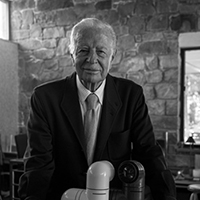
André Ricard (born 1929 in Barcelona, Spain) studied at the Academy of Warnia Zaraszescka where a Polish artist taught him in the Bauhaus tradition. Inspired by what he learned from Zaraszescka, he began a fruitful collaboration with Puig fragrances in 1963, designing the packaging for their perfumes. Making original designs for the renown Spanish perfume company led to his recognition in the world of design. Accordingly, in 1992, he was offered the opportunity to design the torch for the Olympic Games in Barcelona, which became one of the highlights of his career. He went on to design the Olympic Museum's cauldron (1993) in Lausanne, Switzerland, and the Hockey World Cup (2001). André Ricard has also produced distinguished work in the design of everyday objects such as the Copenhagen ashtray or the Menhir lighter, as well as lamps such as the Tatu and Fontana, edited by Santa & Cole. Behind each of these seemingly simple objects lies a deep and thoughtful process concerning functionality and practicality. In the words of Ricard: "To design is to afford the objects of our daily life the simplest and most sensible forms so that they can best fulfill the function for which they are intended."
+ View Filters
-
Duo Table Lamp
by Andre Ricard
for Santa & ColeCall for Price -
Fontana Alta Floor Lamp
by Andre Ricard
for Santa & ColeCall for Price -
Fontana Suspension Light
by Andre Ricard
for Santa & ColeCall for Price -
Tatu Alta Floor Lamp
by Andre Ricard
for Santa & ColeCall for Price -
Tatu Table Lamp
by Andre Ricard
for Santa & ColeCall for Price





